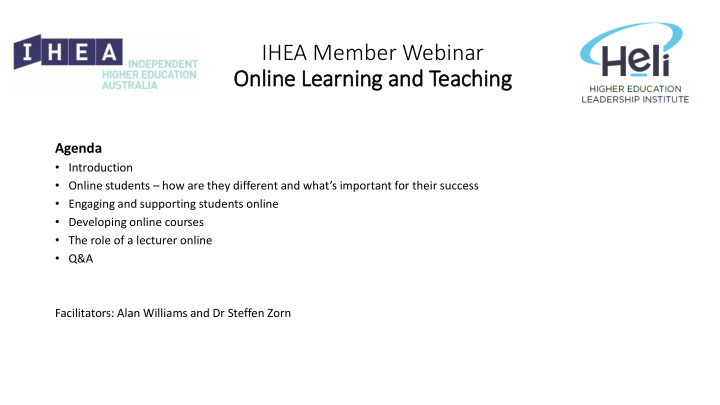



IHEA Member Webinar Onlin line Learning and Teaching Agenda • Introduction • Online students – how are they different and what’s important for their success • Engaging and supporting students online • Developing online courses • The role of a lecturer online • Q&A Facilitators: Alan Williams and Dr Steffen Zorn
In Introduction • HELI – advisory services, mentoring and training to higher education providers • Graduate Certificate in Higher Education Academic Practice : Part-time, 1 year, online, subjects also available as discrete units of study
Onlin line students • Online learning is popular – 1/3 of US students take at least one unit online; 14% are online students in Australia (University Rankings, 2019) • Reasons: family or work commitments, flexibility, more options, convenience (study whenever, wherever) • Mainly non-traditional students; diverse cohort
Onlin line students • How do student characteristics affect learning? Some students p erceive heavy workload → negative influence upon student learning → surface learning approach → limited learning • Strongest influence: learning environment • student-centred approach • good relationships among peers and with the teacher • and teaching itself. • Personal characteristics: intrinsic motivation (computer literacy)
Engaging students onlin line • Student drop-out rates online are significantly higher than F2F • Research showed student engagement influences persistence and retention • In class : responding to students’ posts, and encouraging students to engage with the learning community (peers and lecturer) • Outside of class : may include educational counselling, technical support, library services, study skill sessions, … • Personal level : making things interesting and relevant, timely feedback
Developing onli line courses
Developing onli line courses
Developing onli line courses Despite the hippos' cute appearance, they are among the most dangerous and aggressive of all mammals.
Developing onli line courses Multimedia principle Contiguity principle Coherence principle Learners engaging in only Corresponding words and Interesting but irrelevant details pictures should be verbal content need to might help motivating students. build a pictorial model presented near rather However, adding useful but than far from each other in based solely on the non-essential details can time or on screen presented words overload a student’s working (cognitive load theory) memory. Mayer, R. E. (2013). Ten research-based principles of multimedia learning. In: Web-based learning: Theory, research, and practice (pp. 371 – 390). Taylor and Francis, Hoboken
facilitator The role le of an onli line le lecturer • Facilitate discussion and safe learning environment • Learners are responsible for their learning • Basic technology • LMS (+ additional software) • Online communication topics • Cultural differences
facilitator The role le of an onli line le lecturer Effective online pedagogy • Let students do (most of the work) to increase meaningful engagement among students • Interactivity is key - Student interactions with peers, with the instructor but first and foremost with quality content leads to student satisfaction and success. • Strive for presence - social presence, cognitive presence or teaching presence Pelz, Bill. "(My) three principles of effective online pedagogy." Journal of Asynchronous Learning Networks 14.1 (2010): 103-116.
Q&A
Recommend
More recommend